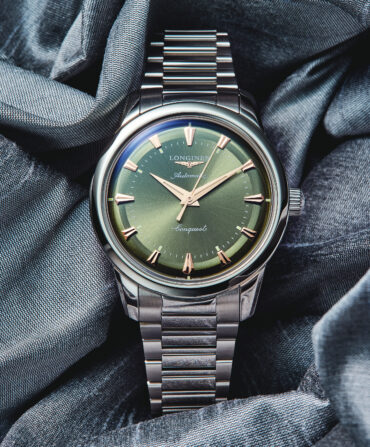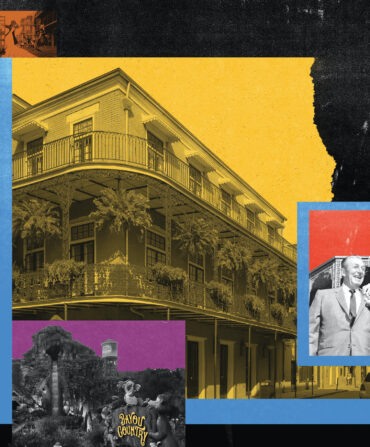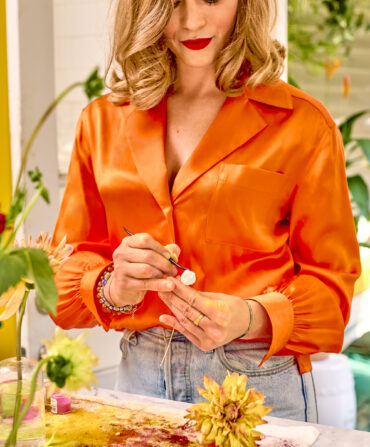Arts & Culture
Wild by Nature
A child of the Lowcountry, West Fraser has risen to the top of American landscape painting by charting his own course through the untamed South
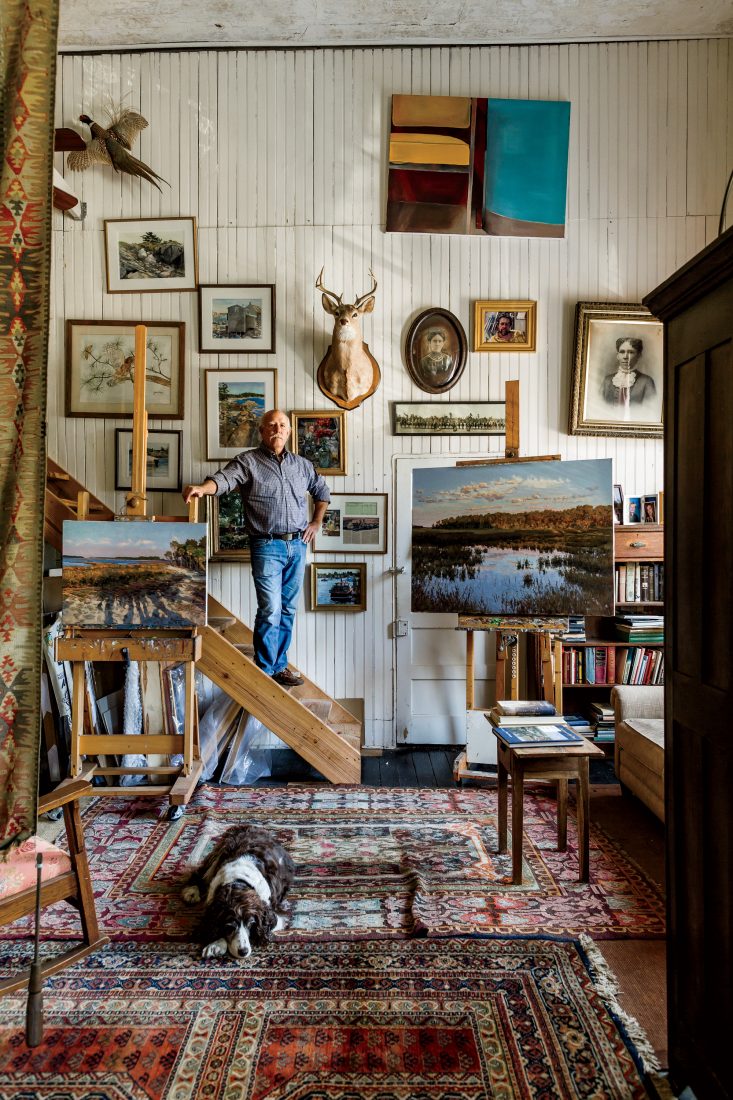
Photo: Peter Frank Edwards
|| MEETING the ARTIST ||
I walk into the dignified, yet casual, Helena Fox Fine Art gallery in downtown Charleston, South Carolina, 106-A Church Street. It’s late morning and I’m looking for West Fraser, the artist. I’ve texted him my ETA. I’m a little nervous.
I’ve seen photos of him…and there he is, seated against the wall. He stands and walks toward me. He has a white walrus mustache like my grandfather had.
We shake hands, chat a minute—normal introduction stuff: my drive down from Wilmington, North Carolina, looks like we have a nice day, and so forth.
Fraser’s wife, Helena, joins us. She owns and runs the gallery. I’ve glanced at the paintings and I’m sure some are Fraser’s. Because I have been painting a few years—and am trying to keep learning—I want to break away and study them, but I’m obliged to be polite, writerly, and well mannered. We three talk a bit about their recent trip to Tuscany. I look more carefully at the art, see some of Fraser’s work—really fine art that I wish I could do when I grow up. I wish I could do it because it’s not sentimental or pretentious in the least, because the paintings feel relaxed and alive, they seem to gently love the light in them—and this man is a hero of my painting mentor back home. So that makes Fraser my granddaddy-hero, or something like that. That’s one reason I’m nervous.

Photo: Peter Frank Edwards
Coastal Canvas
The artist West Fraser with a painting in progress at the Botany Bay Wildlife Management Area on South Carolina's Edisto Island.
I ask him about one of his large paintings on the wall. It’s not one of his Lowcountry landscapes, for which he’s best known, but one in Tuscany. I’ve determined that he is neither eager nor reluctant to talk. That fact relieves me. Since he’s not eager, I can get a word in; since he’s not reluctant, I might get a chance to learn something about painting while I do my job of writing.
He’s telling me a little about the large Tuscany painting and I suddenly do what I know I should not do—what I’m embarrassed at doing. I sneak a look at the price.
Holy moly. Over twice the value of my pickup. And I have a nice truck. (Fraser doesn’t see me look, thank goodness.)
The talking he and I will do through the rest of the day and in the field while he paints, our talk in his studio in the morning, and the research I will do at home later—his awards, the travel, the breadth of subjects, the teaching, his dedication to history, place, people, to relationships (land and sky on the canvas, early Spanish and French explorers, fishermen and developers), his knowledge of color theory and composition, his refusal to “preach” in his paintings or in person, his quiet concern about commercial watermen—all this, and more, help confirm the value of his paintings. He’s the real thing, and I’m suddenly full of more questions than I can organize in my head.
We walk over to a smaller one of his paintings: a dock, a fishing boat, several men, and colorful floating lobster cages. Something about the sky is working well, but I can’t quite figure out what. Then I see a kind of greenish yellow that he’s dropped onto a spot of sky between clouds.
“How did you know to do that?” I ask.
He takes a piece of paper from my notepad, pulls a pencil from his shirt pocket, draws a color wheel.
We’re off. But in the wrong direction. I’m here, as I keep telling myself, to write, not take a free art lesson. But, lo and behold, I see that Fraser, with my granddaddy’s mustache, and now a twinkle in his eye, is ready to talk about anything, about anything I—as student artist, human being, Southerner, novelist, journalist—want to know. And we are about to go eat lunch and then off to Edisto Island, where I’ll watch him paint.
I’m in hog heaven.
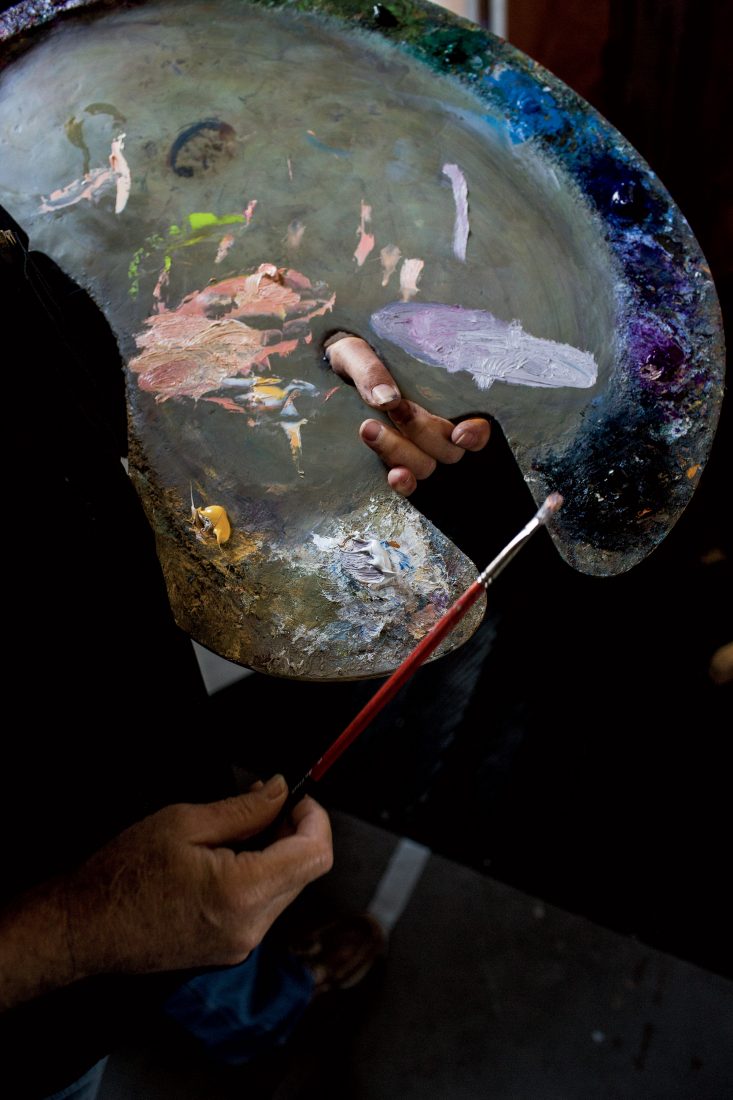
Photo: Peter Frank Edwards
A colorful palatte
|| LIFE in the LOWCOUNTRY ||
But cold oysters on the half shell and fish tacos are on the lunch menu. We sit side by side at the counter in 167 Raw on East Bay Street. We talk not about painting, but about food, about where Fraser grew up (born in Georgia in 1955; moving in 1964, at age nine, to then mostly undeveloped Hilton Head Island). We compare writing and painting jargon—point of view, perspective, focal point, theme. We compare uncles.
I’m learning about how and when the Frasers came to the Lowcountry, way back in 1695: Scottish Highlander, French, Puritan, and Irish influences. His grandfather (an aide to Captain Harry S. Truman), Uncle Charles, Aunt Mary, his grandmother Pearl (who insisted he draw and paint)—they each had a part in guiding Fraser into his passion, his obsession with painting.
It’s not what his father was hoping for.
But it happened anyway, partly as a consequence of West’s Huck Finn adventures on Hilton Head, where as a boy he learned the natural rhythms and moods of the Lowcountry. He’s been regularly painting that land, painting the stories (as he sometimes describes his work), the relationships, since 1984 when he moved to Charleston, moved home that is, from Pennsylvania, where he’d lived as a young illustrator, learning from landscape traditions and artists of the Northeast.
As Fraser moves from fork to fingers on the excellent fish taco, I count the years and realize he has been painting Lowcountry people, places, scenes, marshes, for almost four decades now. As early as 1979, while living in Savannah, he was painting on Daufuskie Island, home to the last intact Gullah community in South Carolina. He’s painted shrimpers and their trawlers in McClellanville, South Carolina, and oyster factory shuckers in Bluffton. His new book, Painting the Southern Coast, collects much of that work in one broad sweep, spanning from Georgetown, South Carolina, to Saint Augustine, Florida.
“Have you seen the book One Place?” I ask him.
“No.” He’s wiping his fingers with a thick white napkin.
“It’s about the photos of Paul Kwilecki, a Georgia photographer. There’s a line in the book where he says he was ‘nourished and wounded’ by the South.”
Fraser carefully places his napkin beside his plate. He turns on his stool and looks at me. Something has happened in his eyes. “That’s a pretty amazing juxtaposition,” he says. He mentions “monuments to excess” as he discusses the pull between “development” and the natural Lowcountry, the effects of runoff on the marsh. “Chemicals are killing our environment and no one seems to care.” And as he talks, I realize that gradually—since his early days on Hilton Head—his heart has been broken. He knows where we are in time now, in development, as a people and a place. He wants to preserve what is left, in fact as well as in his paintings. He mentions Maine, how up there they have managed to preserve the coast and the working waterfront—far more effectively than we have down South.
One reason Fraser is torn somehow is that his father was an original developer of Sea Pines Plantation on Hilton Head—a good man, a valued father. He wanted West to become an architect. West decided to drive a different truck. He relishes his relationships with fishermen and shuckers, relishes the richness of their cultures, bemoans the fact that these human beings are often pushed aside by the big plans of those who don’t see what he sees, and believes, and paints.
|| IN the FIELD ||
I ride in Fraser’s passenger seat as we drive south from Charleston toward Edisto Island, where I will watch him paint. I’m excited for a chance to see how he does what he does. As we ride along, I pepper him with questions.
He learned to paint more or less on his own. His grandmother Pearl kept crayons, pencils, and paper in a kitchen drawer, and encouraged him to draw and color. When he was thirteen, his aunt Mary asked him want he wanted to do when he grew up. “Be an artist,” he said.
His father’s illustrator friend, Coby Whitmore, advised, “Don’t get the boy an art teacher, just get him paints and brushes and let him learn on his own.”
Though he did get a fine arts degree from the University of Georgia in the late seventies, Fraser considers himself self-taught. “I paint to learn,” he says, “rather than learn to paint.” He counts on creative intuition more than “method” to get him from A to B. One of his favorite quotes is from the English art critic and philosopher John Ruskin:
The greatest thing a human soul ever does in this world is to see something and tell what it saw in a plain way. Hundreds of people can talk for one who can think, but thousands can think for one who can see. To see clearly is poetry, prophecy, and religion all in one.
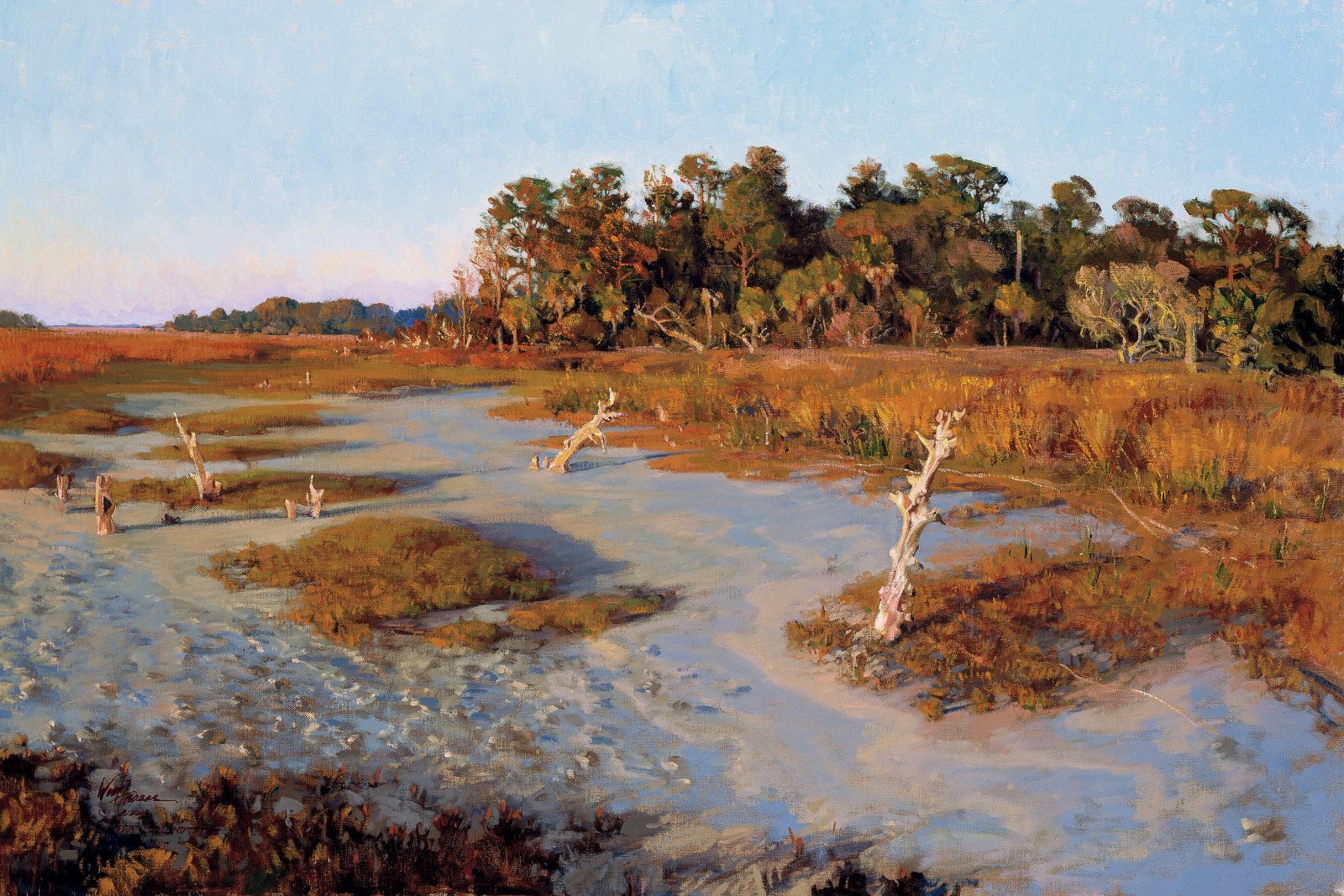
Photo: West Fraser
Bear Island Flats, Bear Island, South Carolina (24" x 36" oil)
On Edisto, at the Botany Bay Wildlife Management Area, we find a place to park under tall trees, get out, stretch. Fraser opens his trunk, gets out and puts on a broad-brimmed hat, and pulls out a heavy backpack. He puts on a dark shirt (you don’t want light reflecting onto your painting), hoists the backpack, and we are off along a sandy trail that cuts across the marsh like a single straight road across a desert.
It’s a fine clear day. A breeze to keep away the gnats. It’s afternoon, three-thirty or so. I can’t explain the view to you—it’s too vast and flat for accurate words. A distant tree line to the north. A distant dune line hiding the ocean to the south. It’s a bit otherworldly. Very few people. Colors are subdued, gray. The fresh green of spring has not quite arrived.
You see for miles and miles across the flat marsh toward the north. Fraser stands, looks, turns, looks, walks down off the main path to a spot on a narrower path. Out into the marsh a ways, back up onto the main path. I follow along.
“Sometimes,” he says, “I stand, look, walk, and search for over an hour. Find nothing to hit me right. So I go home.”
Finally he stops on the main path. He drops the backpack to the ground, unzips it, gets out an easel with telescoping legs, and begins to set up. There is that nice breeze. It’s slightly overcast, but mainly it’s sunny, not too hot. A partially dead cedar tree stands out in front of us. Otherwise there is marsh, as I see it.
Fraser points to the ground between us and the cedar. “See the shapes?”
Well, hell no, I don’t see no shapes. But I don’t say that.
“Look at that,” he says—and points. “There. And over there.”
And then I do! Game trails diverge and come together, large patches of grass join smaller patches. “Oh, yes, now I see.”
“Shapes,” he says. “And look down, see what you see. Look around to the left and right. Many painters will hold up their fingers in a kind of square and find something way out there to paint. I like for the viewer of the picture to feel in the scene, on the ground, in the place. I want the viewer to feel the temperature, smell the smells.”
I will study some of Fraser’s paintings later, study them closely, and I will see that he does what he sets out to do. (Another reason he can buy two of my trucks with one of his paintings.) In several of his paintings, the viewer faces a rising moon in the east with a setting sun out of sight, behind the viewer. No, it’s not sentimental, as you might think. Those paintings put me on the ground, on earth. I am there so precisely and thoroughly I can feel the time of day, the atmospheric pressure.
Fraser opens the easel, places a board in position to paint on, squeezes out dabs of paint onto his palette.
“Do you mind if I ask questions?” I ask.
“Not at all.”
I figured he wouldn’t, but we are entering a slightly different phase of things. We are getting into the sacred part.
He makes some outlining marks, sort of thrown onto the board. He sketches here, there, brings in a little color, mixes some grays on his palette.
Halfway through, maybe forty minutes in, the painting does not look very good—to me. I keep my mouth shut about that, of course, but I wonder what Fraser is thinking. (I will later learn that he was thinking the same thing.)
Then he starts talking about relationships, about color theory, composition, a little over my head. I am fighting mentally to keep up. Then it strikes me that some of those relationships he is talking about, has been talking about earlier, are not at all unlike those I try to teach to my writing students. Painting: the green here as it relates to the gray there. Writing: the sergeant’s dialogue as it relates to the meanness of his captain. Painting: the blue that indicates distance. Writing: the mood that weakens the effect of a character’s action.
But I keep quiet, listen, and watch as the scene he paints almost suddenly comes alive. Pop. Ka-bam. Whop-a-do. That distant tree line that had seemed kind of close suddenly falls away—way, way back into the distance of the painting. Individual weeds and stalks suddenly appear as Fraser plays some magic trick with his palette knife, slapping and skipping the edge of it across the lower third of the painting.
Then he finishes, packs up, and we walk to the car and ride home. Along the way, he points ahead at the long, narrow sandy road coming toward us, under us. “See those shadows across the road?” he asks.
“Yes.”
“Compare the value of the white sandy road hit by light to the sky value and temperature. Set that in your head. Then you observe the middle tones and dark values of the shadows and compare them. Too often artists make skies and shadows too dark, and that throws them off scale. Like a couple of bad notes on the piano, it’s hard to recover.”
I’m taking notes. The day is almost over. I’ve learned as much about painting as a day will hold.
The next morning at eight I will meet Fraser in his large, ancient, high-ceilinged studio with tall north-facing windows and I will listen as he tells me about early explorers of the Lowcountry, as he pulls out old maps of rivers, paintings of the early Indians. He will talk about how those Indians were considered to be noble princes and kings, how they were transported in their tattooed and feathered splendor to Europe, were marveled over and admired…until we needed to take their glorious, breathtaking land.
Finally, it will be time to go. But before I leave, he will give me this quote from the Pennsylvania artist Martha Erlebacher:
I think we re-create the visual world as a hedge against death. Every time we make a picture of something we are creating a parallel universe which will outlast us.…The implication for mortality is that although we may perish, our “land” will not.
West Fraser—and the land he’s painted into our heads and hearts—will be here a long time after he’s gone.


